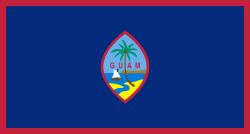Barrigada (Barrigada Village)
Barrigada (Barigåda) is a village in the United States territory of Guam. A largely residential municipality, its main village is located south of the Antonio B. Won Pat International Airport near the intersections of Routes 8, 10, and 16. The community east of the airport known as Barrigada Heights is considered an affluent neighborhood on the island, where homes have excellent views overlooking much of Guam including the island's airport and hotels along Tumon Bay. Another significant location is Mount Barrigada, nearly 200 meters above sea level. Its location in the center of the island means it houses most of the island's radio masts and towers; the position and height make it easier for radio signals to reach the entire island.
From 2 to 4 August 1944, the United States Marine Corps engaged troops from the Empire of Japan at present-day Barrigada Heights during the battle of Guam, a year before the end of the Second World War. When the Japanese line collapsed, American forces pursued them to the north, winning the battle. In recent years, the three main highways in Barrigada have been renamed in honor of the U.S. Military. Route 8 is designated Purple Heart Memorial Highway; Route 10 is designated Vietnam Veterans Highway; and Route 16 is designated Army Drive.
From 2 to 4 August 1944, the United States Marine Corps engaged troops from the Empire of Japan at present-day Barrigada Heights during the battle of Guam, a year before the end of the Second World War. When the Japanese line collapsed, American forces pursued them to the north, winning the battle. In recent years, the three main highways in Barrigada have been renamed in honor of the U.S. Military. Route 8 is designated Purple Heart Memorial Highway; Route 10 is designated Vietnam Veterans Highway; and Route 16 is designated Army Drive.
Map - Barrigada (Barrigada Village)
Map
Country - Guam
 |
 |
People born on Guam are American citizens but are politically disenfranchised, having no vote in the United States presidential elections while residing on Guam. Guam delegates to the United States House of Representatives have no vote on the floor. Indigenous Guamanians are the Chamoru, historically known as the Chamorro, who are related to the Austronesian peoples of Malay archipelago, the Philippines, Taiwan, and Polynesia. But unlike most of its neighbors, Chamorro language is not classified as a Micronesian or Polynesian language. Rather, like Palauan, it possibly constitutes an independent branch of the Malayo-Polynesian language family. As of 2022, Guam's population is 168,801. Chamorros are the largest ethnic group, but a minority on the multi-ethnic island. The territory spans 210 mi2 and has a population density of 775 /mi2. The Chamorro people settled the island approximately 3,500 years ago. Portuguese explorer Ferdinand Magellan, while in the service of Spain, was the first European to visit the island on March 6, 1521. Guam was colonized by Spain in 1668. Between the 16th and 18th centuries, Guam was an important stopover for the Spanish Manila Galleons. During the Spanish–American War, the United States captured Guam on June 21, 1898. Under the 1898 Treaty of Paris, Spain ceded Guam to the U.S. effective April 11, 1899.
Currency / Language
| ISO | Currency | Symbol | Significant figures |
|---|---|---|---|
| USD | United States dollar | $ | 2 |
| ISO | Language |
|---|---|
| CH | Chamorro language |
| EN | English language |















